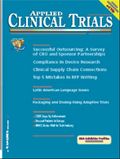New FDA Liaison Opens Up
Hear from the first FDA liaison in the Office of International Programs.
New FDA Liaison Opens Up
As part of the U.S.-EU Transatlantic Administrative Simplification Plan, FDA and EMEA will both send one staff member to each other's agency headquarters to serve a two-year term as liaison in the Office of International Programs. FDA has selected 20-year agency veteran Janice Soreth, MD, whose experience includes serving as CDER's director of the division of Anti-Infectives and Ophthalmology as well as working in CBER and the Office of Combination Products/Office of the Commissioner.

Janice M. Soreth
Applied Clinical Trials spoke with Dr. Soreth about her upcoming move to London and how she feels about her new position as Deputy Director (Medical Products) Europe, Office of International Programs, U.S. FDA.
Q: What influenced you to apply for this position?
A: The opportunity to serve abroad, to advance the mission of FDA through global health diplomacy touched a deep chord within me. My first job after residency was overseas, far from Washington, in the setting of an emerging island nation. It was an eye-opener in many respects, especially regarding availability of health care and medical products beyond the borders of the United States.
Q: Why is this exchange important?
A: Part of FDA's statutory mission is to work with foreign regulatory authorities to harmonize regulatory requirements and try to reduce regulatory burdens, so establishing these liaison positions fits right in with that mandate. Beyond that, it's a common sense thing to do. Medical product development is interconnected globally like never before, so the United States will get a lot out of close collaboration with EMEA, using a risk-based, life-cycle approach for medical products.
Q: How would you describe the impact this exchange will have on the U.S. and EU agencies?
A: We have very cordial ties now, but there are limits to what you can do with phone calls and visits. I think that embedding an official in each other's agency will have a very positive effect on our cooperation, on understanding the way each partner thinks.
Q: How will all your experience at FDA help you serve?
A: I wouldn't feel comfortable taking this assignment if I had not had the opportunity to serve in a range of jobs in the agency, starting as a primary reviewer, as well as experience living abroad. I'm grateful that the FDA has taken my professional development seriously and has given me the chance to, among other things, go through the Leadership Development Program. And I can't say enough about the mentoring I've received over the years, especially that of Drs. Mac Lumpkin and Janet Woodcock.
Q: What do you hope to accomplish?
A: I'm proud of the way we work as an agency team...of how seriously the FDA takes its mission of safeguarding the U.S. public; and from the outset, I want to communicate our positiveness and professionalism. And in an age of global health concerns, I think it's more urgent than ever to build close relationships with our international partners.

Unifying Industry to Better Understand GCP Guidance
May 7th 2025In this episode of the Applied Clinical Trials Podcast, David Nickerson, head of clinical quality management at EMD Serono; and Arlene Lee, director of product management, data quality & risk management solutions at Medidata, discuss the newest ICH E6(R3) GCP guidelines as well as how TransCelerate and ACRO have partnered to help stakeholders better acclimate to these guidelines.
Phase III PROMINENT Trial Initiated to Evaluate Felzartamab for Primary Membranous Nephropathy
June 30th 2025The global Phase III PROMINENT trial has begun dosing patients to evaluate felzartamab in treating primary membranous nephropathy, a serious autoimmune kidney disorder with no FDA-approved therapies.
Funding Cuts Threaten Diversity in Clinical Research
June 27th 2025In this video interview, Kyle McAllister, co-founder, CEO, Trially, discusses how recent federal funding cuts are likely to undermine research focused on underrepresented populations, and why long-term investment in community-based studies is essential to closing persistent health equity gaps.